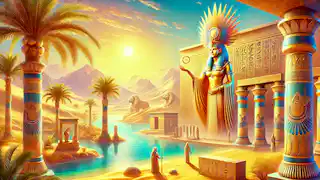In the golden sands of ancient Egypt, beyond the river Nile, lies a story deeply woven into the hearts and beliefs of an entire civilization. This is the story of Ma'at, a divine principle that symbolized truth, balance, order, harmony, law, morality, and justice. Ma'at wasn’t just a goddess; she was the very essence of Egypt's soul. Her influence stretched across the heavens, through the land, and into the underworld, guiding the living and the dead. To understand Ma'at is to step into the footsteps of pharaohs, priests, and common folk who revered her as the essence of existence itself.
Our tale begins at the dawn of time when chaos reigned, and the gods convened to bring order to the universe. In the beginning, there was only Nun, the chaotic primordial waters that held all potential within them. From Nun emerged Atum, the first god, who birthed all other gods and brought forth Shu, the god of air, and Tefnut, the goddess of moisture. These two created Geb, the god of the earth, and Nut, the goddess of the sky. Together, these deities shaped the world, but it was Ma'at who gave it purpose, balance, and direction. Ma'at emerged from the very essence of creation, an intangible force brought into form by the gods. She was not created in the traditional sense; rather, she was born from the need for harmony and order. As the gods shaped the earth, it became clear that without a guiding principle, the balance would be fragile. Thus, Ma'at was born, representing the highest ideals of cosmic order, justice, and balance. Ma'at’s role was profound: she provided the moral and cosmic foundation upon which all creation could stand. She was depicted as a woman with a feather on her head, symbolizing the feather of truth and balance. This feather, light yet essential, became the measure against which souls were weighed in the afterlife. For centuries, the concept of Ma'at shaped the governance of Egypt. The pharaohs, considered living gods, were seen as the ultimate keepers of Ma'at on earth. Their duty was not only to rule but to uphold Ma'at in all they did. A pharaoh who failed to maintain Ma'at risked plunging the land into chaos and darkness. From the earliest rulers, pharaohs understood that their legitimacy stemmed from their adherence to Ma'at. Their rule was marked by a delicate balance between power and responsibility, as they sought to embody justice, truth, and harmony. The pharaohs enacted laws, settled disputes, and made offerings to the gods, all in the name of upholding Ma'at. The stability and prosperity of Egypt depended on their commitment to her principles. In court, pharaohs would wear the feather of Ma'at, symbolizing their dedication to truth. They presided over trials, ensuring that the weak received justice and that truth prevailed. This commitment to Ma'at became not only a political mandate but a spiritual one, as each pharaoh sought the goddess’s blessing to guide his or her rule. Ma'at’s influence was not limited to pharaohs and the ruling elite. Her principles were woven into the daily lives of all Egyptians, regardless of social status. Farmers, merchants, priests, and artisans all lived by the idea that harmony was essential for personal happiness and community well-being. Egyptians believed that by adhering to Ma'at, they maintained the balance of life and death, prosperity and ruin. Common Egyptians took care to live in accordance with Ma'at by showing respect to their neighbors, taking care of their families, and avoiding conflict whenever possible. They offered prayers to Ma'at, hoping to avoid misfortune and to live in harmony with nature. Every action had the potential to either support or disrupt Ma'at, so people were mindful in their daily tasks, treating others with respect and honesty. In temples, priests recited hymns praising Ma'at, and the people joined in to express their gratitude for the balance that kept the Nile flowing and the crops growing. The goddess’s presence was felt in the rhythm of life, from the sowing of seeds to the reaping of the harvest, in marriages, births, and even deaths. Ma'at was the divine heartbeat that kept Egypt thriving. In the Egyptian belief system, the journey of the soul did not end with death. Instead, the deceased would face the judgment of Osiris, the god of the underworld. Ma'at played a pivotal role in this process, as it was her feather of truth that determined the fate of the soul. The soul’s journey through the afterlife was filled with challenges, but the most critical was the Weighing of the Heart. In the Hall of Two Truths, the heart of the deceased was placed on a scale against Ma'at’s feather. If the heart was lighter than the feather, the soul was considered pure and granted entry into the Field of Reeds, an eternal paradise. However, if the heart was heavy with lies, deceit, or cruelty, it would tip the scales, condemning the soul to be devoured by Ammit, the soul-eater. The Egyptians believed that a lifetime of good deeds, kindness, and respect for Ma'at would prepare them for this moment. From their first breath to their last, they were mindful of Ma'at’s teachings, aware that every lie, act of cruelty, or selfish deed added weight to their heart. In this way, Ma'at served as both a guide in life and a judge in death. Throughout Egypt, temples were built in honor of Ma'at. Though not as numerous as those dedicated to gods like Amun or Isis, these temples held a unique significance. In these sacred spaces, priests offered prayers and conducted rituals to ensure that Ma'at’s influence permeated every corner of the kingdom. The Temple of Ma'at in Karnak was one of the most revered, a testament to the Egyptians’ dedication to maintaining cosmic balance. Priests of Ma'at played a crucial role, not only in performing rituals but also in interpreting the will of the gods and advising the pharaohs. They were seen as custodians of truth and were expected to lead lives free from corruption and selfishness. In the temples, they recited hymns to Ma'at and offered sacrifices to ensure the continued prosperity and balance of Egypt. These ceremonies reminded the people that their collective actions were essential to upholding Ma'at. As centuries passed, Egypt faced invasions, internal strife, and the rise of other civilizations. The prominence of Ma'at began to wane as foreign rulers imposed their own beliefs and practices upon the land. With the arrival of new religions and philosophies, the ancient faith in Ma'at started to transform, merging with other spiritual ideas. However, Ma'at’s legacy did not disappear. The principles of truth, balance, and justice continued to influence Egyptian culture and even found echoes in other societies. Although the temples were eventually abandoned, and the rituals ceased, the memory of Ma'at lived on in the hearts of the people. She became a symbol of the resilience and endurance of Egypt itself, a testament to a time when harmony and justice were the cornerstones of life. Even in modern times, Ma'at remains a symbol of balance and justice. Scholars, historians, and spiritual seekers continue to study her teachings, finding relevance in her principles. Ma'at's influence extends beyond ancient Egypt, reaching those who value harmony, integrity, and fairness. In the feather of truth, we find a reminder that humanity’s actions echo throughout time, influencing both the living world and the eternal. Ma'at’s story is more than a myth; it’s a call to each generation to strive for justice, to act with compassion, and to seek balance in a world that often leans toward chaos. Through her, we understand that harmony is not just a state of being but a continuous effort, a commitment to living in accordance with truth. The story of Ma'at serves as a reminder that balance is not an endpoint but a journey. Just as the ancient Egyptians sought to uphold Ma'at in all aspects of their lives, we too are invited to bring balance into our own. Ma'at’s legacy calls us to act with integrity, to seek justice, and to live with compassion. In doing so, we contribute to a world that reflects her principles and honors her timeless wisdom. In the end, Ma'at’s feather is not just a symbol of truth but a beacon, guiding us toward a life of purpose and harmony. Like the Egyptians of old, we are tasked with carrying her light forward, ensuring that justice and balance continue to shape our world.The Birth of Ma'at
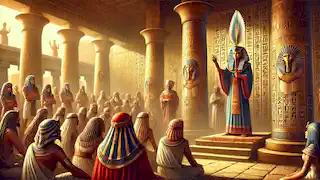
The Influence of Ma'at on the Pharaohs
Ma'at and the Common People
Ma'at and the Weighing of the Heart
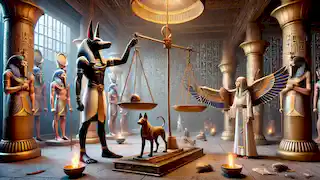
The Temples of Ma'at
Ma'at’s Decline and Transformation
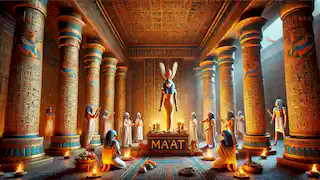
The Legacy of Ma'at
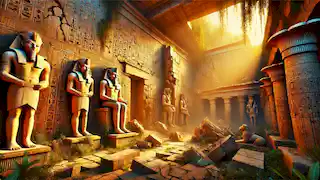
Epilogue: A Call to Balance
